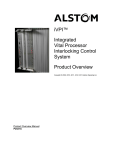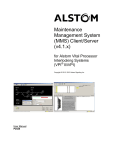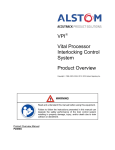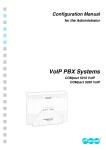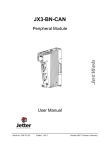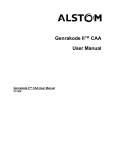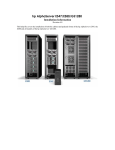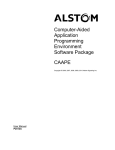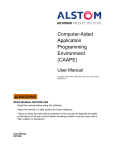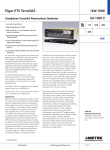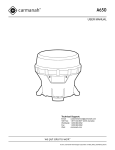Download iVPI Installation, Operation, and Theory
Transcript
iVPI™ Integrated Vital Processor Interlocking Control System Installation, Operation, and Theory Copyright © 2008, 2011, 2012, 2013 Alstom Signaling Inc. Installation, Operation and Theory Manual P2521B, Volume 1 iVPI™ Integrated Vital Processor Interlocking Control System Installation, Operation, and Theory Copyright © 2008, 2011, 2012, 2013 Alstom Signaling Inc. Installation, Operation and Theory Manual Alstom Signaling Inc. P2521B, Volume 1, Rev. E, November 2013, Printed in U.S.A. LIST OF EFFECTIVE PAGES P2521B, Volume 1, iVPI Integrated Vital Processor Interlocking Control System Installation, Operation, and Theory Manual ORIGINAL ISSUE DATE: October 2008 CURRENT REVISION AND DATE: Rev E, November 2013 PAGE CHANGE OR REVISION LEVEL Cover Nov/13 Title page Nov/13 Preface Nov/13 i through iv Nov/13 1–1 through 1–24 Nov/13 2–1 through 2–10 Nov/13 3–1 through 3–12 Nov/13 4–1 through 4–12 Nov/13 A–1 through A–6 Nov/13 P2521B, Volume 1, Rev. E, Nov/13 Alstom Signaling Inc. THIS PAGE INTENTIONALLY LEFT BLANK. P2521B, Volume 1, Rev. E, Nov/13 Alstom Signaling Inc. PREFACE NOTICE OF CONFIDENTIAL INFORMATION Information contained herein is confidential and is the property of Alstom Signaling Inc. Where furnished with a proposal, the recipient shall use it solely to evaluate the proposal. Where furnished to customer, it shall be used solely for the purposes of inspection, installation or maintenance. Where furnished to a supplier, it shall be used solely in the performance of the contract. The information shall not be used or disclosed by the recipient for any other purposes whatsoever. VPI®, WEE-Z®, and Microchron® are registered trademarks of Alstom Signaling Inc. GM4000A™, iVPI™, microWIU™, and VCS™ are trademarks of Alstom Signaling Inc. All other trademarks referenced herein are trademarks of their respective owners. FOR QUESTIONS AND INQUIRIES, CONTACT CUSTOMER SERVICE AT 1-800-717-4477 OR WWW.ALSTOMSIGNALINGSOLUTIONS.COM ALSTOM SIGNALING INC. 1025 JOHN STREET WEST HENRIETTA, NY 14586 REVISION LOG Revision Date Description By Checked Approved 1(A) October 2008 Original issue MAS NI NI 2(B) February 2011 Updated with commercialized components MAS RIH NI 3(C) March 2012 Updated to include BEX boards, cables, and chassis JF RIH NI 4(D) February 2013 Updated LR MG/KW NI November 2013 Updated to correct Tables 2-3 and 2-4 SG KW MS E P2521B, Volume 1, Rev. E, Nov/13 Alstom Signaling Inc. THIS PAGE INTENTIONALLY LEFT BLANK. P2521B, Volume 1, Rev. E, Nov/13 Alstom Signaling Inc. ABOUT THE MANUAL This manual is intended to introduce the Alstom Integrated Vital Processor Interlocking Control System, (iVPI), including an installation overview and theory of operation. This manual is part of a five volume set of manuals summarized in Section 1. The information in this manual is arranged into sections. The title and a brief description of each section follow: Section 1 – GENERAL DESCRIPTION: This section describes the manual organization, introduces the topics covered, and introduces the iVPI System. Section 2 – CONFIGURATION OVERVIEW, INSTALLATION AND SETUP: This section provides a general overview of the field installation and setup of the iVPI System, including capacity guidelines. Section 3 – OPERATION: This section gives general information on the operation of the iVPI System. Section 4 – THEORY OF OPERATION: This section gives general information on the operation of the iVPI System. Appendix A – GLOSSARY: This section provides a glossary of the terms used in the five volumes of this manual set. P2521B, Volume 1, Rev. E, Nov/13 Alstom Signaling Inc. THIS PAGE INTENTIONALLY LEFT BLANK. P2521B, Volume 1, Rev. E, Nov/13 Alstom Signaling Inc. MANUAL SPECIAL NOTATIONS In the Alstom manuals, three methods are used to convey special informational notations. These notations are warnings, cautions, and notes. Both warnings and cautions are readily noticeable by boldface type and a box around the entire informational statement. Warning A warning is the most important notation to heed. A warning is used to tell the reader that special attention needs to be paid to the message because if the instructions or advice is not followed when working on the equipment then the result could be either serious harm or death. The sudden, unexpected operation of a switch machine, for example, or the technician contacting the third rail could lead to personal injury or death. An example of a typical warning notice follows: WARNING Disconnect motor energy whenever working on switch layout or switch machine. Unexpected operation of machine could cause injury from open gears, electrical shock, or moving switch points. Caution A caution statement is used when an operating or maintenance procedure, practice, condition, or statement, which if not strictly adhered to, could result in damage to or destruction of equipment. A typical caution found in a manual is as follows: CAUTION Turn power off before attempting to remove or insert circuit boards into a module. Boards can be damaged if power is not turned off. Note A note is normally used to provide minor additional information to the reader to explain the reason for a given step in a test procedure or to just provide a background detail. An example of the use of a note follows: Note: This step should be done first to validate the correct information is used. P2521B, Volume 1, Rev. E, Nov/13 Alstom Signaling Inc. THIS PAGE INTENTIONALLY LEFT BLANK. P2521B, Volume 1, Rev. E, Nov/13 Alstom Signaling Inc. TABLE OF CONTENTS Topic Page SECTION 1 – GENERAL DESCRIPTION ................................................................... 1–1 1.1 INTRODUCTION ....................................................................................... 1–1 1.2 MANUAL SET ORGANIZATION ................................................................ 1–1 1.3 RELATED PUBLICATIONS ....................................................................... 1–2 1.4 TERMS, ABBREVIATIONS AND TRADE NAMES .................................... 1–3 1.4.1 System Terms ................................................................................. 1–3 1.5 SUBSYSTEMS .......................................................................................... 1–4 1.6 SYSTEM FEATURES ................................................................................ 1–7 1.7 VERSATILE APPLICATION SCENARIOS FOR IVPI .............................. 1–10 1.7.1 Freight Railroad Applications ........................................................ 1–13 1.7.2 Commuter Rail Applications .......................................................... 1–14 1.7.3 Light Rail Applications ................................................................... 1–14 1.7.3.1 ATP Support ......................................................................... 1–15 1.7.3.2 Equipment Location .............................................................. 1–15 1.7.3.3 Information Communication .................................................. 1–15 1.7.3.4 Application Integration........................................................... 1–15 1.7.4 Heavy Rail Transit Applications..................................................... 1–16 1.7.4.1 Large Interlockings ................................................................ 1–16 1.8 ETHERNET CONNECTIVITY OVERVIEW .............................................. 1–17 1.9 SPECIFICATIONS ................................................................................... 1–19 1.10 REDUNDANCY, AVAILABILITY AND ISOLATION ................................. 1–21 1.10.1 Redundancy .................................................................................. 1–21 1.10.2 Availability ..................................................................................... 1–21 1.10.3 Isolation ......................................................................................... 1–21 1.11 DIAGNOSTICS ........................................................................................ 1–22 1.12 MAINTENANCE MANAGEMENT SYSTEM ............................................ 1–23 SECTION 2 – CONFIGURATION OVERVIEW, INSTALLATION AND SETUP ......... 2–1 2.1 INTRODUCTION ....................................................................................... 2–1 2.2 CAPACITY OVERVIEW............................................................................. 2–1 2.2.1 Hardware Criteria ............................................................................ 2–2 2.3 UNPACKING AND INSPECTION .............................................................. 2–3 2.4 MAIN SYSTEM ID ..................................................................................... 2–3 2.5 MOUNTING PROCEDURE ....................................................................... 2–4 2.6 PRE-POWER-UP CHECKS....................................................................... 2–5 2.7 SOFTWARE CONFIGURATION ............................................................... 2–6 P2521B, Volume 1, Rev. E, Nov/13 i Alstom Signaling Inc. TABLE OF CONTENTS Topic Page 2.7.1 AlsDload Software........................................................................... 2–6 2.8 SYSTEM CONFIGURATION DATA........................................................... 2–7 2.9 GENERAL DIAGNOSTICS ........................................................................ 2–9 SECTION 3 – OPERATION ...................................................................................... 3–11 3.1 INTRODUCTION ..................................................................................... 3–11 3.2 START-UP PROCEDURE ....................................................................... 3–11 3.3 OPERATING INSTRUCTIONS ................................................................ 3–11 3.4 OPERATING UNDER UNUSUAL CONDITIONS .................................... 3–11 3.5 OPERATIONAL CHANGES..................................................................... 3–11 3.6 SHUTDOWN PROCEDURE .................................................................... 3–12 SECTION 4 – THEORY OF OPERATION ................................................................... 4–1 4.1 INTRODUCTION ....................................................................................... 4–1 4.2 VITAL SYSTEM OPERATION ................................................................... 4–2 4.2.1 Vital System Operation ................................................................... 4–3 4.2.2 Output Loads................................................................................... 4–3 4.3 NON-VITAL SYSTEM OPERATION .......................................................... 4–4 4.3.1 Non-Vital Processing....................................................................... 4–4 4.3.2 Diagnostics For Non-Vital iVPI ........................................................ 4–4 4.4 SYSTEM CASE (SUBRACK)..................................................................... 4–6 4.4.1 Motherboard .................................................................................... 4–9 4.4.2 System Expansion .......................................................................... 4–9 4.4.3 Power Supply Consideration ........................................................... 4–9 4.5 NON-VITAL SYSTEM AND COMMUNICATIONS SOFTWARE .............. 4–10 4.5.1 I/O Application ............................................................................... 4–10 4.5.2 Communication Protocols ............................................................. 4–11 APPENDIX A – GLOSSARY ...................................................................................... A–1 P2521B, Volume 1, Rev. E, Nov/13 ii Alstom Signaling Inc. LIST OF FIGURES Figure No. Title Figure 1–1. Figure 1–2. Figure 1–3. Figure 1–4. Figure 1–5. Figure 1–6. iVPI Rack and Subrack ................................................................... 1–3 Vital and Non-Vital Subsystems ...................................................... 1–4 Overall Architecture, iVPI-Based Interlocking.................................. 1–5 Example iVPI Vital / Non-Vital System Application ........................ 1–11 Example iVPI Expansion System Application................................ 1–12 Independent Ethernet Backbones Vital Devices Separate from Non-Vital Devices.................................................................. 1–17 Redundant Ethernet Backbones Supporting Vital and NonVital Devices ................................................................................. 1–18 Example MMS Connection Configuration...................................... 1–23 Figure 1–7. Figure 1–8. Figure 4–1. Figure 4–2. Figure 4–3. Figure 4–4. Page Functional Logic Flow...................................................................... 4–2 NVSP Diagnostic Connection.......................................................... 4–5 iVPI Boards Grouped by Vital and Non-Vital Functions .................. 4–7 Typical Board Placement for Single 21-slot Subrack iVPI System ............................................................................................ 4–8 P2521B, Volume 1, Rev. E, Nov/13 iii Alstom Signaling Inc. LIST OF TABLES Table No. Title Table 1–1. iVPI Specifications ........................................................................ 1–19 Table 2–1. Table 2–2. Table 2–3. Table 2–4. Table 2–5. Vital Board Hardware Criteria .......................................................... 2–2 Non-Vital Board Hardware Criteria .................................................. 2–2 iVPI Main Subrack System ID Configuration Procedure ................. 2–3 iVPI Mounting Procedure ................................................................ 2–4 iVPI Pre Power-up Checks Procedure ............................................ 2–5 Table 2–6. Table 4–1. VSP Log Sheet................................................................................ 2–8 Communication Protocols ............................................................. 4–11 Table A–1. Glossary .......................................................................................... A–1 P2521B, Volume 1, Rev. E, Nov/13 Page iv Alstom Signaling Inc. General Description SECTION 1 – GENERAL DESCRIPTION 1.1 INTRODUCTION This document contains a general description of the Alstom iVPI™ (integrated Vital Processor Interlocking) Control System. It contains basic system level information, technical hardware descriptions, and maintenance and troubleshooting instructions. The technical material in this manual assumes the reader has a basic knowledge of railroad signaling terminology, digital electronics, and basic computer software principles. Courses are available for the user that requires additional training. Contact an Alstom representative for details. 1.2 MANUAL SET ORGANIZATION This manual is part of a five volume set supporting the iVPI system. The set is organized as follows: • Volume 1, Installation, Operation, and Theory Manual, is this document. It includes a general overview of the field installation and setup of the iVPI system; including capacity guidelines and allowable GTP/NVSP board combinations, system operation, and theory of operation. • Volume 2, Subrack Configuration, describes the subrack configuration including cables and power supplies. • Volume 3, Vital Subsystem, includes the Vital subsystem board drawings and board reference data. • Volume 4, Non-Vital Subsystem, includes non-vital subsystem board drawings and board reference data. • Volume 5, Maintenance and Troubleshooting, describes system maintenance and troubleshooting, including discussion of diagnostics and references for the applicable software and hardware manuals. P2521B, Volume 1, Rev. E, Nov/13 1–1 Alstom Signaling Inc. General Description 1.3 RELATED PUBLICATIONS Several additional publications pertain to the iVPI system: • P2521A, iVPI Product Overview • P2346, Series: Code/Communication System Publications (contact Alstom Signaling Inc.’s Customer Service at 1-800-717-4477 for a specific protocol) • P2509 Maintenance Management System for Alstom Vital Processor Interlocking Systems (VPI, VPI II, iVPI) • P2528 MMS Client/Server for Alstom Vital Processor Interlocking Systems (VPI II/iVPI). • P2512A, CAAPE User Manual • P2512B, AlsDload Software Download User Manual • P2512E, DataLogger • P2512F, iVPI CAA Reference Manual P2521B, Volume 1, Rev. E, Nov/13 1–2 Alstom Signaling Inc. General Description 1.4 TERMS, ABBREVIATIONS AND TRADE NAMES Terms and abbreviations used throughout this five volume manual set are defined in Appendix A. Refer to Appendix A whenever a term or abbreviation in the text is unfamiliar. VPI® is a registered trade name of Alstom Signaling Inc, while iVPI™ and Safety Assurance Logic™ are trademarks of Alstom Signaling Inc. 1.4.1 System Terms The iVPI System is modular in design, implemented in one or more Subracks with a set of plug-in eurocard style printed circuit boards applied in varying quantities to meet the needs of specific applications. The terminology used to define the Subrack and its components is as follows: • A Subrack is a Chassis with Motherboard • A System is one or more Subracks filled with the appropriate boards for the application • When a System is configured with more than one Subrack populated with boards, the individual populated Subracks are Subsystems Figure 1–1. iVPI Rack and Subrack P2521B, Volume 1, Rev. E, Nov/13 1–3 Alstom Signaling Inc. General Description 1.5 SUBSYSTEMS Figure 1–2 is a block diagram of the boards in the Vital and non-vital subsystems. BUS 9- 16 vdc Supply Power Islolation Unit Local Control Panel (Serial) Ethernet Ports IP Adresses Serial Ports Software Timers Event Logger Flash PROM Ethernet NVSP Serial Interfaces PLC's Ethernet Ethernet Ports Vital Sftw Timers IP Addresses VRD Relay VSP Flash PROM Electronic Cfg Bus Interface Relay Contacts Track Circuit Relays SBO DI AC Signal Lighting ACO DBO Switch Indications Switch Controls Relays DC Signal Lighting LDO CRG Code Following Electronic Module Code Following Relay Local Control Panel Discrete Wiring NVI Local Control Panel Discrete Wiring NVO 2 Tracks / Board Flash PROM GTP Figure 1–2. Vital and Non-Vital Subsystems P2521B, Volume 1, Rev. E, Nov/13 1–4 Alstom Signaling Inc. General Description Alstom's iVPI System seamlessly integrates Vital and non-vital functions, including Vital and non-vital communications. With Ethernet networking capability, iVPI can communicate with up to 32 1 Systems using the Vital Serial Over Ethernet (VSOE) protocol. The Interlocking subsystem provides the Vital fail-safe interface with the signaling Field Equipment. The electronic interlocking is Alstom's integrated Vital Processing Interlocking (iVPI) control system. See Figure 1–3 for general iVPI product architecture. Non-Vital Subsystem Vital Communications Vital Subsystem Remote Control NVSP LOGIC & COM iVPI VSP APP SW I/O I/O I/O Vital Network Figure 1–3. Overall Architecture, iVPI-Based Interlocking 1 Maximum system size is application-dependent P2521B, Volume 1, Rev. E, Nov/13 1–5 Alstom Signaling Inc. General Description The iVPI control system consists of a: • Fail-safe Vital System Processor (VSP) with integrated Vital network communications adapter supporting VSOE, other Vital protocols and the Alstom Maintenance Management System (MMS). • Family of fail-safe Vital I/O to/from remote signaling devices and Vital field apparatus such as switch machines, train stops, track circuits, signal lamps and LED arrays, highway crossing equipment, cab signaling equipment, and more • Integrated Genrakode Track Processor (GTP) where required for direct interface at control points to the coded track circuits. Other integrated Track Circuit functions are possible • Integrated Code Rate Generator (CRG) for generating the speed command pulses used to modulate the carrier frequency (for example, 60 Hz) for track circuits within the interlocking plant and at the interlocking end of the approach track circuits • Non-Vital System Processor (NVSP) interface with the Control System with integrated Ethernet TCP/IP, synchronous, and asynchronous communication channels capable of simultaneously supporting multiple communication protocols and MMS • Non-Vital Input and Output boards (NVI and NVO) interface with non-vital signaling apparatus such as Local Control Panels, Intrusion alarms, non-vital train inspection equipment, and more P2521B, Volume 1, Rev. E, Nov/13 1–6 Alstom Signaling Inc. General Description 1.6 SYSTEM FEATURES The iVPI system is a Vital fail-safe, microprocessor-based control system designed to meet the needs of interlocking control for mainline railroads and mass transit applications. Designed as a modular control system, iVPI contains a set of plug-in Printed Circuit Boards applied in varying quantities to meet the needs of a specific project. A single iVPI system may include one to four subracks depending on I/O and arrangement. Single iVPI systems can control interlockings with up to 40 2 switch machines. Although one iVPI system is sufficient for many installations, for sites that have specific availability or configuration requirements applications can include additional systems. (* The actual number of switch machines is application-specific) No special heating or cooling equipment is required for iVPI operation in AREMAspecified environments of Class C or Class D (-40 to +70° C), including small wayside shelters. iVPI includes built-in secondary transient protection for all I/O lines to prevent disruption of service from lightning or other local interference. Inputs to the iVPI system are identical to older, Vital relay-based systems. No interface relays are used in the solid-state system, thereby eliminating the need for periodic maintenance or adjustments. With iVPI, complex relay logic is: • reduced to a closed set of Boolean mathematical expressions, or • expressed as Relay Logic Diagrams representing standard relay contact closures Through Alstom's Computer-Aided Application Programming Environment (CAAPE) software package, Boolean expressions are converted into operating instructions for the iVPI microprocessor. Both Vital and non-vital applications are created with the same user interface. The CAAPE software package is also used to configure the hardware of the iVPI subrack. 2 Maximum number is application-dependent. P2521B, Volume 1, Rev. E, Nov/13 1–7 Alstom Signaling Inc. General Description The tool set includes a graphical simulator that allows the signal engineer to exercise the logic before building the hardware. The simulator provides a mechanism for the signal engineer to demonstrate the operation of the interlocking before the design is complete. As such, it can offer clarifying detail to design reviews. The simulator can also be used in presenting the application design to non-signaling personnel, e.g., operating personnel, to insure that the signal design adequately supports the operational needs. • The iVPI system has separate subsystems for Vital and non-vital control. The Vital and non-vital logic and hardware are maintained as separate subsystems, allowing modifications in one section to not affect the other. These subsystems may share a subrack or be configured in separate subracks. • Scalability / Modularity – iVPI systems can be arranged in many user programmable system configurations ranging from: – Fully centralized logic and I/O; to – Centralized logic with remote I/O and object controllers; to – Fully distributed self-standing systems • Network Interfaces – the iVPI platform provides improved integration with transparent interface to radio offerings, providing Vital and non-vital communications to fit the need of the application. Included in the networking improvements is the addition of Ethernet connectivity, described in detail in Section 1.8 • System Maintainability – iVPI supports more cost effective maintenance than other systems, including the: – Inclusion of "health status" monitors on the front panel of each board, simplifying and reducing maintenance time, – Elimination of wire wraps eliminates potential rewiring expense, Vital I/O headers and Signature PROMS, – Eurocard 9U Subrack and surface mount boards reduce potential future obsolescence issues, and – Electronic revision configuration control simplifies the new FRA compliance rules • Plug & Play Capability – only two boards in the new iVPI subrack require a specific slot location. The VSP board is a doublewide board assigned to slots 1 and 2. The single slot wide NVSP board can be assigned to any of slots 3 through 8. Any other board used in the system may be plugged into any slot other than 1 or 2 without fear of damaging the boards or subrack while reducing both setup and restore time as well as maintenance requirements. • Compatibility – the iVPI platform is fully compatible with previous versions of the VPI family, and is designed for long life cycle support and upgrades. P2521B, Volume 1, Rev. E, Nov/13 1–8 Alstom Signaling Inc. General Description • Redundant vs. Non-Redundant – iVPI Systems can operate with no redundancy while providing extremely high reliability and availability to System and Subsystem arrangements with redundant pairs to provide hot standby and automatic failover. • System Testing – the iVPI VSP board has both a main Logic processor as well as a Communications processor with separate application programming that minimizes retesting. This results in lower system costs due to less time spent servicing the system. • System Safety – the iVPI platform is based on the proven VPI and Genrakode safety design case that includes a MTBHE (Mean Time Between Hazardous Events) of better than 1013 hours and a history of zero safety incidents. • Spares – smaller systems with fewer boards result in lower spares requirements. Requiring fewer rack mounted power supplies (by moving the power supplies directly to each system board) results in further reductions to spares inventory. Even further spares reductions occur when a system uses the GTP board for track circuit control. iVPI integrates this functionality into one system, alleviating the previously required Genrakode module and boards. • Application Software Changes – through use of the CAAPE tool, the engineer or maintainer can flash programs and verify CRCs directly to the VSP and NVSP boards. There is no need for external PROM burners or PC RS232 converter devices. P2521B, Volume 1, Rev. E, Nov/13 1–9 Alstom Signaling Inc. General Description 1.7 VERSATILE APPLICATION SCENARIOS FOR IVPI Compared to other solutions, with iVPI's wide range of scalability and interconnectivity, there is greater flexibility to deploy signaling components in a way that facilitates greater savings. This ranges from smaller room arrangements, to use of small cases where larger rooms were once required, to the placing of the control functions closer to the device being controlled, saving on cable costs. This new approach, made possible by reducing the form factor of the Vital and non-vital hardware and the use of network connectivity makes it possible to provide a "best fit" solution to all types of signaling applications. Figure 1–4 is block diagram of an example iVPI application using every board type available for the iVPI System. Figure 1–5 is an example iVPI using the expansion system. P2521B, Volume 1, Rev. E, Nov/13 1–10 Alstom Signaling Inc. General Description BUS 9- 16 vdc Supply Power Islolation Unit Local Control Panel (Serial) Ethernet Ports IP Adresses Serial Ports Software Timers Event Logger Flash PROM Ethernet NVSP Serial Interfaces PLC's Ethernet Ethernet Ports Vital Sftw Timers IP Addresses VRD Relay VSP Flash PROM Electronic Cfg Bus Interface Relay Contacts Track Circuit Relays SBO DI AC Signal Lighting ACO DBO Switch Indications Switch Controls Relays DC Signal Lighting LDO CRG Code Following Electronic Module Code Following Relay Local Control Panel Discrete Wiring NVI Local Control Panel Discrete Wiring NVO 2 Tracks / Board Flash PROM GTP Figure 1–4. Example iVPI Vital / Non-Vital System Application P2521B, Volume 1, Rev. E, Nov/13 1–11 Alstom Signaling Inc. General Description BUS 9-16 vdc Supply Power Islolation Unit VPI Bus Expansion Board Bus Expansion Cable to VSP BEX Relay Contacts Relays Track Circuit DI SBO Switch Indications Switch Controls AC Signal Lighting ACO DBO Relays DC Signal Lighting LDO 2 Tracks / Board GTP Flash PROM Code Following Relay CRG Figure 1–5. Example iVPI Expansion System Application P2521B, Volume 1, Rev. E, Nov/13 1–12 Alstom Signaling Inc. General Description 1.7.1 Freight Railroad Applications The interlocking function for traditional block signaling applications generally requires a combination of: • Power supply for interlocking • Signaling logic (Vital and non-vital) • Local emergency control • Communications to a central office with an industry standard protocol • Local signal and switch machine interfaces • Local track occupancies and approach track circuits using DC Coded track circuits • Vital disconnect of load power in case of a safety critical failure In iVPI this is accomplished by the use of one electronics system containing: • A Vital interlocking processor with signaling logic and network connections (Ethernet) to other Systems and MMS diagnostics for 24/7 troubleshooting • A non-vital processor (if required) for non-vital logic, event recording, local emergency control, interface to CTC, or other including network interfaces for intrasystem communications, MMS diagnostics for 24/7 monitoring and event log uploads • Vital I/O to drive switch and signal and other Vital equipment • An integrated track circuit for providing full track circuit functionality • Non-Vital I/O as needed through the use of third party I/O systems with a serial link and/or Ethernet to the non-vital processor or non-vital I/O boards • Power from the local signaling batteries is provided directly to the iVPI System with no intermediate power supply elements • A Vital 'B' relay is provided to deliver energy feeds for Vital output circuits in absence of any safety critical failures; backs of the relay are used to light red aspects should a failure occur The system is capable of providing the status of all interlocking inputs to the Positive Train Control (PTC) network via an optional, external micro Wayside Interface Unit (microWIU). This hardware configuration is contained in small rack or case (one control system), supplied with customer pre-engineered application logic rules and ordered with one part number. P2521B, Volume 1, Rev. E, Nov/13 1–13 Alstom Signaling Inc. General Description 1.7.2 Commuter Rail Applications In North America Commuter Rail Lines, equipment used is typically that of Freight lines with added cab signaling equipment. In addition to the requirements described in 1.7.1 Freight Railroad Applications, this application has cab signal requirements: • Cab signal rate codes assigned per track within the interlocking • Cab signal rate codes assigned per track on approach track circuits For iVPI Commuter Rail use: • An integrated track circuit provides full track circuit (AC or DC Electrified or nonelectrified functionality) • A rate code generator has outputs that can be coded at any of standard NA and Freight rates (e.g. 75, 120, 180, 220, 470…PPM) For Full Commuter rail applications including intermediate/adjacent track circuits, the same track circuit function integrated within iVPI system can operate in a standalone mode along with a cab signal system to deliver coded rates to the rails. 1.7.3 Light Rail Applications Light Rail applications can take two forms; one where trains run on traditional Freight lines and others that are more like street level trams. Freight based lines must meet the requirements described in 1.7.1 Freight Railroad Applications and may or may not include cab signaling or other ATP functions. The requirements represent a superset of those items generally required and provided for with iVPI. For systems that mimic a transit orientation, iVPI can integrate many different functions depending on the requirements and type of system desired. This includes: • Interfaces to Automatic Train Protection (ATP) Systems; both for train detection and including several levels of cab signaling. ATP logic is resident within the same processor as the signaling logic for the interlocking • Formation of small Vital control elements using the same hardware and software that can be located centrally to a wayside control room (or case) or distributed along the right of way • Ease of integration with supplier specified non-vital control systems where required to perform local supervisory control, routing functions, or Train to Wayside Communication (TWC) functions P2521B, Volume 1, Rev. E, Nov/13 1–14 Alstom Signaling Inc. General Description 1.7.3.1 ATP Support iVPI includes the light rail application interfaces described in Section 1.7.3 as well as an interface through the network to Audio Frequency and Digital track circuits where another form of ATP is required. The network interface allows the track circuits to be located in the main equipment room or along the right of way to minimize the use of extended and costly to add cable runs. 1.7.3.2 Equipment Location iVPI can be configured to place the location logic resident within the Vital and/or nonvital processors in an equipment house or case while the I/O can be located within the same room or placed at the location of the device to be controlled. This allows the remote functions to be self-sufficient from a safety perspective. The remote functions have their own Vital checking function. This provides a high level of availability, as a failure to a remote function does not affect the overall location. 1.7.3.3 Information Communication The LRT application of iVPI includes software and hardware interfaces to support Vital and non-vital communications via network over fiber, radio, direct wire, or Ethernet. An iVPI unit can communicate location-to-location, location-to-control center or location-totrain in a bidirectional manner. 1.7.3.4 Application Integration For applications that require the use of a third-party non-vital control system for local emergency control or train routing, iVPI has standard interfaces to communicate status and control data using industry standard protocols such as Modbus or train to wayside communications for routing. P2521B, Volume 1, Rev. E, Nov/13 1–15 Alstom Signaling Inc. General Description 1.7.4 Heavy Rail Transit Applications iVPI can support heavy rail Metro/Transit applications with its wide variety of input and output boards. Capacity is not an issue as one iVPI system can manage an interlocking with 1 to 40 3 switch machines while at the same time processing all non-vital logic and communications and interfaces to ATC subsystems. iVPI software and hardware are configurable to support: • Fixed block signaling for interlockings including integrated ATC (Cab Signaling) Logic • Extensive wayside ATS functions such as driving local hard wired panels, ATO functions such as station stopping and dwell, SCADA type functions, and HMI workstations • Vital and non-vital communications over wire, fiber, radio, or Ethernet • Local or remote diagnostics and event recording • Network interface with AF Track Circuits or Digital Track Circuits to provide speed commands or temporary speed commands to the vehicle through the rails 1.7.4.1 Large Interlockings The iVPI can manage: • A small Vital or non-vital control function with one or two boards • A medium location with up to 203 switch machines and associated signals controlled by a single iVPI system. A large location with hundreds of switch machines and associated signals controlled by multiple iVPI systems or with a control logic processor iVPI is configured to support these applications simply by adding the necessary I/O, Serial and/or Ethernet interfaces. An iVPI System can expand from one control Subrack to four Subracks as required for centralized equipment rooms, or simply configured to partition into a standalone System as needed. A total of 640 Vital and 640 non-vital I/O points can be managed directly under the control of each Vital and non-vital processor (when configured as one complete System) or expanded greater with interconnected systems using Ethernet for a distributed approach. 3 Maximum number is application-dependent. P2521B, Volume 1, Rev. E, Nov/13 1–16 Alstom Signaling Inc. General Description 1.8 ETHERNET CONNECTIVITY OVERVIEW Each of the iVPI processor boards (both Vital and Non-Vital) contains two Ethernet devices that are configured in independent or redundant networks. This allows Vital and non-vital messages to be mixed on the same network or to be kept independent from each other on separate networks. Each device also supports multiple node connections and protocols. Using the Vital Serial over Ethernet (VSOE) Communications, the two devices on the Vital Serial Processor (VSP) board can handle up to 32 4 VSOE nodes and one MMS node. These can be set up as redundant or non-redundant. The NVSP board has similar capabilities that service office communications protocols (serially and/or Ethernet) and MMS connections. Both boards could share the same network if there is sufficient bandwidth. See Figure 1–6 and Figure 1–7 for examples of independent and redundant Ethernet backbones. Ethernet Switch (Non-Vital Network) Ethernet Switch (Vital Network) D e v i c e . 2 D e v i c e . 1 V S P D e v i c e . 2 D e v i c e . 1 N V S P Figure 1–6. Independent Ethernet Backbones Vital Devices Separate from Non-Vital Devices 4 Maximum number is application-dependent. P2521B, Volume 1, Rev. E, Nov/13 1–17 Alstom Signaling Inc. General Description Ethernet Switch (Network A) Ethernet Switch (Network B) D e v i c e . 1 D e v i c e . 2 V S P D e v i c e . 1 D e v i c e . 2 N V S P Figure 1–7. Redundant Ethernet Backbones Supporting Vital and Non-Vital Devices • VSP Ethernet Connections The VSP board has two Ethernet ports that each support up to 325 VSOE links. The MMS tool MAC-Diagnostic uses a TCP connection. The Vital processor board supports one MMS connection at a time and can view the states of up to 128 5 parameters. An example configuration follows: – A redundant Ethernet backbone with up to 32 VSOE links over 1-UDP on Device 1 and the backup 32 VSOE Links over 1-UDP on Device 2. • • In addition one MAC-Diagnostic TCP connection is open NVSP Ethernet Connections The NVSP board has two Ethernet ports that support up to 10-TCP Ethernet connections. Each MMS tool supports MAC-Diagnostic, Tracker and Panel communications using one TCP connection. Other communication protocols each require their own TCP connections. The non-vital processor board supports one MMS connection at a time and can view the states of up to 128 variables. 5 Maximum number is application-dependent. P2521B, Volume 1, Rev. E, Nov/13 1–18 Alstom Signaling Inc. General Description 1.9 SPECIFICATIONS Table 1–1 provides the nominal specifications for the iVPI system (subrack and boards). Additional board voltages can be supported as required by specific applications. The term iVPI represents a generic platform that can be used in Freight, Commuter, Light Rail and Heavy Rail Transit applications. Table 1–1. iVPI Specifications (Cont.) Product Characteristics Input Power Alstom iVPI (Typical per System) 9 to 16 VDC at 15 amperes maximum per system High Voltage Isolation Rating Meets AREMA Wayside Class C and Class D requirements Operating Temperature -40 to +160º F (-40 to +70º C) Meets AREMA Wayside Class C and Class D requirements Humidity 0 to 95% Non-Condensing Meets AREMA Wayside Class C and Class D requirements Typical Weight per System with some boards 15 lbs. (6.80 kg) Dimensions 14H × 19W × 23D* inches (35.6H × 48.3W × 58.5D cm) * Depth includes cable dress at rear of subrack Number of Track Circuits Supported by GTP Up to 20 track circuits per System, 2 track circuits per GTP, 10 boards per System Maximum Track Circuit Length Supported by GTP 24,000 feet @ 3 ohms per 1,000 feet ballast nonelectrified territory Lamp Control 8 outputs per board Cab Signal Generator Controls 8 outputs per board; maximum 3 boards per System Operating Voltages 9 to 16 VDC Networking Capability VSP has 2 Ethernet Device Interfaces for connectivity of up to 32 6 nodes using the VSOE protocol plus MMS NVSP has 2 Ethernet Device Interfaces that support up to 10 TCP/IP connections plus MMS Scalability Control of a single switch point to a complex interlocking 6 Maximum number is application-dependent. P2521B, Volume 1, Rev. E, Nov/13 1–19 Alstom Signaling Inc. General Description Table 1–1. iVPI Specifications (Cont.) Product Characteristics Alstom iVPI (Typical per System) Recorder Logging Capability Approximately 50,000 events, expandable to > 100,000 Graceful Degradation Achievable between interlocking control and track circuits through system partitioning Vital Output Boards Outputs 8 outputs per board; maximum 40 boards per System, 320 ports Lamp Driver Output (LDO) 9 to 18 VDC at loads up to 3.3 amps Single Break Output (SBO) 9 to 30 VDC at loads up to 0.5 amps • Double Break Output (DBO) • • • AC Output (ACO) -01: 10 to 16 VDC with loads between 250 and 3,000 ohms -02: 10 to 15 VDC with loads between 250 and 3,000 ohms -01: 90 to 130 VAC at loads up to 0.8 amps -02: 90 to 130 VAC at loads up to 0.5 amps Vital Input Boards Inputs 16 inputs per board; maximum 20 boards per System, 320 ports • • • Direct Input (DI) -01: 9 to 16 VDC -02: 9 to 16 VDC -03: 24 to 34 VDC Non-Vital Input and Output Boards Inputs 32 inputs per board Outputs 32 outputs per board Boards per System 20 Non-Vital Output (NVO) • • Non-Vital Input (NVI) P2521B, Volume 1, Rev. E, Nov/13 • • -01: 0 to 35 VDC (Relay contact port at loads up to 0.5 amps) -02: 0 to 35 VDC (SS Relay at loads up to 0.5 amps) -01: 18 to 36 VDC -02: 9 to 18 VDC 1–20 Alstom Signaling Inc. General Description 1.10 1.10.1 REDUNDANCY, AVAILABILITY AND ISOLATION Redundancy The iVPI meets the needs of applications requiring Hot, Warm or Cold standby redundancy. The very high reliability of the electronics supports many applications with only one controlling System in many cases. Historically, failures encountered have been those effecting I/O circuitry. Therefore, full System redundancy is suggested, in line with a high availability System requirement. iVPI requires that all software and hardware is strictly configured and controlled internally, so proof (between the Systems) that the Systems are of the same version and revision is not necessary. Any change that influences the safety elements of the System is revealed to the user in reports from the System tools and from the on-line System itself. Any configurability issue results in the effected System functioning in a more restrictive operating state until the issue is corrected. 1.10.2 Availability Hot Standby configurations use active application parameters to indicate the current state of the interlocking. During a transfer initiated due to failure(s) of one System, the standby System seamlessly transitions to control field elements as long as the application parameters are appropriate. With iVPI's superior diagnostics capability, failures are identified quickly and repaired (MTTR < 30min) without affecting the online System. 1.10.3 Isolation The network capability of iVPI permits I/O to be isolated from the central interlocking logic based on customer preference or in unique harsh environments. The I/O Systems need only to provide I/O interface functions. If an I/O System should fail, only that System is affected. This provides a higher level of availability for the interlocking. The decision to use isolated Systems must take into account the cost of hardware, engineering, and installation logistics. P2521B, Volume 1, Rev. E, Nov/13 1–21 Alstom Signaling Inc. General Description 1.11 DIAGNOSTICS Four diagnostic support alternatives exist for troubleshooting an iVPI system: • LEDs on circuit boards for visual operating checks • AlsDload Software Download program used to download application software and configure system • Watcher software that allows monitoring of Vital and non-vital variables in near real time at the field location with a laptop computer (IBM compatible PC) • MMS, a graphical Diagnostic and Maintenance Application that uses a graphical Track Layout to dynamically record and display the iVPI diagnostic status, the status of linked iVPI variables and play recorded data (on location or remotely) In addition, non-vital system diagnostics are performed with a properly equipped data terminal. P2521B, Volume 1, Rev. E, Nov/13 1–22 Alstom Signaling Inc. General Description 1.12 MAINTENANCE MANAGEMENT SYSTEM The Maintenance Management System (MMS) is an Alstom diagnostic tool that can remotely monitor each iVPI Vital and non-vital networked system. MMS is a graphical diagnostic and maintenance application that uses a graphical track layout to dynamically record and display the iVPI diagnostic status, the status of linked iVPI variables and play back recorded data. Additional tools are available to manage diagnostics, configuration, event and data logs, schedule maintenance tasks, and view, record and play back iVPI application variable data. For more information on this Alstom tool, refer to Alstom publication P2509 Maintenance Management System for Alstom Vital Processor Interlocking Systems (VPI, VPI II, iVPI) or P2528 MMS Client/Server for Alstom Vital Processor Interlocking Systems (VPI II/iVPI). The example MMS configuration in Figure 1–8 includes using Ethernet connections for both the VSP and NVSP boards. MMS Connect ion Using iVPI-NVSP and iVPI-VSP Boards Ethernet 802.3i/u Switch Switch MMS PC (one at a time) MMS PC (one at a time) TCP/IP MAC-Diag Panel TCP/IP MAC-Diag Enet Devices 1&2 Tracker Ethernet Devices 1&2 MAC RS232/USB NVSP DPRAM VPI SysBus VSP MAC RS232/USB RS232Asyn 19.2K RS232Asyn 19.2K Figure 1–8. Example MMS Connection Configuration P2521B, Volume 1, Rev. E, Nov/13 1–23 Alstom Signaling Inc. General Description THIS PAGE INTENTIONALLY LEFT BLANK. P2521B, Volume 1, Rev. E, Nov/13 1–24 Alstom Signaling Inc. Configuration Overview, Installation and Setup SECTION 2 – CONFIGURATION OVERVIEW, INSTALLATION AND SETUP 2.1 INTRODUCTION This section includes the information required to install and configure the software of the iVPI system for regular service. The iVPI system is composed of a rack or wall mounted subrack populated with boards. Installation instructions for a rack mounted stand-alone device are included in this section. See the location Book of Plans for additional hardware detail and/or other installation configurations. WARNING Disruption of iVPI operation poses a potential threat to rail safety. Before shutting down for any reason, notify the railroad dispatcher in charge of the affected route(s). Take all steps necessary to ensure the safe passage of traffic is maintained. 2.2 CAPACITY OVERVIEW iVPI configuration has specific system and subrack capacity guidelines. The application engineer should be aware of the specific rules about board placement and board combination within an iVPI system. Several factors dictate how large of an application one iVPI system can support. Due to the various hardware configurations and application logic requirements, it can be challenging to determine whether the application size exceeds that which one system can properly execute until the design is completed. However, there are criteria available that define the upper boundary. General guidelines for estimating the capacity of an applied iVPI system are in Table 2–1 and Table 2–2. Process time can be estimated by using a spreadsheet within the iVPI CAA. Consult Alstom if a more exact system estimate is required. P2521B, Volume 1, Rev. E, Nov/13 2–1 Alstom Signaling Inc. Configuration Overview, Installation and Setup 2.2.1 Hardware Criteria For the largest applied system there are certain limits concerning the number of certain printed circuit boards that may be used. System form factor dictates some board usage limits while system processing determines others. Table 2–1 and Table 2–2 list boards by board type and indicate maximum number of boards allowed per iVPI system. Table 2–1. Vital Board Hardware Criteria Vital Board Type Boards Per System VSP 1 Vital Inputs (all types) 16 Inputs/board 20 Vital Outputs (all types) 8 Outputs/board 40 GTP 10 Code Rate Generator (CRG) 3 Table 2–2. Non-Vital Board Hardware Criteria Non-Vital Board Type Boards Per System NVSP 4 Non-Vital I/O (NVI and NVO) P2521B, Volume 1, Rev. E, Nov/13 19 boards/NVSP subsystem 2–2 Alstom Signaling Inc. Configuration Overview, Installation and Setup 2.3 UNPACKING AND INSPECTION Carefully open the shipping carton and check the contents against the packing list secured to the outside of the container. Accessories and spare parts kits arrive wrapped separately. Take careful note of all small hardware shipped with the units. Inspect all items for signs of damage. Report any discrepancies or damage to Alstom Signaling Inc. Save all packing material for possible re-shipment. 2.4 MAIN SYSTEM ID The System ID is a combination of the site ID and revision ID. Pins on the System ID Interface board are located at the rear of P2, slot 1 of the iVPI subrack. The four switches on the IO board must be set to the correct value required for the Vital system software to run. This value is determined when the revision and/or site ID parameters are specified while using CAAPE to compile the system software. Table 2–3. iVPI Main Subrack System ID Configuration Procedure Step Procedure 1 Refer to CAAPE to determine the System ID (revision and site ID) assigned to the subrack. This data is available in the GUI (Graphical User Interface)and the .cfg configuration file. Note: Example from .cfg file: ( SYSTEM ID = 65473 (0xFFC1) ). The four-digit value to enter on the thumbwheel would be, from left to right, FFC1. 2 Use the thumb wheel switches on the System ID Interface board to select the System ID to match what is shown in the .cfg configuration file. P2521B, Volume 1, Rev. E, Nov/13 2–3 Alstom Signaling Inc. Configuration Overview, Installation and Setup 2.5 MOUNTING PROCEDURE Each iVPI installation differs slightly depending on the type of rack enclosure used and the types of equipment to be controlled. While it is impossible to anticipate all mounting configurations, this procedure serves as a guide for typical systems. Table 2–4. iVPI Mounting Procedure Step Procedure 1 Install, if required, clip-on nuts at the rack holes for iVPI system mounting. 2 Line up the holes on the front panel of the iVPI system with the mounting holes/nuts in the rack frame. VSP NVSP DI DI DI DI DBO DBO DBO DBO LDO LDO SBO SBO ACO ACO GTP GTP Secure the system to the rack with screws. 3 Connect the iVPI ground wire. 4 Connect all rear panel cables (if applicable) as required by the system plans. Tighten the retaining screws or clips (if so equipped) on the cable plugs to secure them to the iVPI rear panel. Dress all cabling in accordance with the system plans. Note: Some iVPI racks may have either 18 or 32 VAC heavy-duty surge protectors mounted on a panel to handle unwanted line surges. P2521B, Volume 1, Rev. E, Nov/13 2–4 Alstom Signaling Inc. Configuration Overview, Installation and Setup 2.6 PRE-POWER-UP CHECKS Once the equipment is mounted, and before application of power, perform the procedure provided in Table 2–5. Table 2–5. iVPI Pre Power-up Checks Procedure Step Procedure 1 Verify that any power supplies, batteries and chargers used with the iVPI system adhere to operating specifications. The iVPI power supply, if other than provided by Alstom, should be 9 to 16 VDC (1% ripple) and must meet isolation requirements, as found in AREMA Manual Part 11.5.1 if the primary energy source is Vital. 3 Verify VRD relay and repeaters are securely fastened to the relay plugboards. The system does not operate if this is not done. 4 Check all output wiring for shorts to avoid possible damage to the system outputs. Check all power connections for the correct voltage and polarity. 5 Verify that all plug-in printed circuit boards are firmly seated in the correct slots. P2521B, Volume 1, Rev. E, Nov/13 2–5 Alstom Signaling Inc. Configuration Overview, Installation and Setup 2.7 SOFTWARE CONFIGURATION Before the iVPI system is activated, the interlocking logic must be configured to meet the needs of the particular installation. The application logic is configured by using Alstom's CAAPE software. The configuration data produced by CAAPE software is used to program the iVPI's Flash (programmable read-only memory used with embedded processors, see Appendix A). For instructions on using the CAAPE package, refer to the CAAPE's on-line help. See P2512B, AlsDload Software Download Program User Manual, for details about using the AlsDload Software Download Program to program a VSP or NVSP board without removing the board from the system. While the iVPI Vital system software is common to all installations, the application data structure, which describes the logical operation of a specific interlocking, needs to be customized for each location. These Boolean equations or Relay Logic Diagrams are written by the Application or Signal Engineer using the CAAPE software in conjunction with traditional tools such as a track plan and aspect charts. These equations may also be written as a direct interpretation of existing relay logic circuits. After the equations are written, the logic can be simulated, loaded into the boards, and must be tested. WARNING CAAPE software is used to process a set of equations to develop a fail-safe system. No user modification of CAAPE or any of its component programs is allowed because ANY PROGRAM CHANGE could compromise the safety performance of the system. 2.7.1 AlsDload Software The Alstom AlsDload software utility, a part of CAAPE, is used to program application and system software. It can be used to download software or configure a system. For detailed information about AlsDload, refer to Alstom publication P2512B, AlsDload Software Download Program User Manual. P2521B, Volume 1, Rev. E, Nov/13 2–6 Alstom Signaling Inc. Configuration Overview, Installation and Setup 2.8 SYSTEM CONFIGURATION DATA Whenever a new or modified iVPI system is put into service, the system configuration data should be recorded using the ".CFG" report generated by the CAAPE. This provides a means to verify that the CAAPE instructions exactly match the Flash contents residing on the Vital system boards. Although not strictly required, it is recommended that during other (non-VPI or non-iVPI) periodic maintenance programs that the iVPI logic configuration be re-recorded and verified against the installed/in service configuration data. This ensures that the on-site documentation reflects current configuration and is kept up to date. AlsDload can be used to download an application to a VSP board. AlsDload is discussed further later in this document. Use the form provided in Table 2–6 to log the configuration data. Reproduce the form locally as needed. P2521B, Volume 1, Rev. E, Nov/13 2–7 Alstom Signaling Inc. Configuration Overview, Installation and Setup SOFTWARE CONFIGURATION DATA LOG Name of Person Performing System Query: Location of System: System Description ( e.g., SYSTEM 1 or MAIN SYSTEM or application name ): IN SERVICE Date: Current Date: Following "RPT" Command: CAA FILE # INPUT FILE # RUNDATE/TIME VRS FILE# VRS DATE BOOTLOADER FILE # BOOTLOADER DATE BOOTLOADER SIG. SYSTEM SOFTWARE SIG. APPLICATION SIG. FSSVT SIG. Rev ID Site ID Table 2–6. VSP Log Sheet P2521B, Volume 1, Rev. E, Nov/13 2–8 Alstom Signaling Inc. Configuration Overview, Installation and Setup 2.9 GENERAL DIAGNOSTICS Note: For systems configured to communicate over an Ethernet connection, use HyperTerminal or AlsDload via the MAC ports (USB or serial) on the VSP or NVSP boards to access the VT100 terminal diagnostic interface. Refer to P2521B, Volume 5, Maintenance and Troubleshooting, for more information on making a direct connection between the VT100 Emulator and the iVPI system. Using a PC with AlsDload software or an alternate VT100 terminal emulation package connected to the VSP board, apply iVPI system power and observe the display screen: • If operation is correct, "SYSTEM OK" is displayed and the VRD relay energizes after several seconds. • If connections to system inputs or outputs are open or intermittent, the "SYS WARNING" message may be observed. This type of failure may still allow the VRD relay to energize. • If a major fault is detected, the display reads "ERROR ALERT." The VRD relay remains de-energized in such cases. • If the VRD relay remains de-energized and no display message is shown, verify that the application memory has been properly configured and installed on the VSP and that the PC is properly connected. If the failure persists, replace the VSP board. • If an "ERROR ALERT" or "SYS WARNING" display is shown, refer to P2521B, Volume 5, Maintenance and Troubleshooting, for in-depth troubleshooting procedures. P2521B, Volume 1, Rev. E, Nov/13 2–9 Alstom Signaling Inc. Configuration Overview, Installation and Setup THIS PAGE INTENTIONALLY LEFT BLANK. P2521B, Volume 1, Rev. E, Nov/13 2–10 Alstom Signaling Inc. Operation SECTION 3 – OPERATION 3.1 INTRODUCTION This section provides iVPI in-service operating instructions for units installed and configured as described in Section 2. 3.2 START-UP PROCEDURE The iVPI system requires no warm-up period; it is ready for use immediately after receiving power. Simply apply system power to the system to begin Vital controller operation. The power switch is typically located on or near the rack structure. 3.3 OPERATING INSTRUCTIONS The iVPI system provides automatic, unattended field operation. Once power is applied, no operator intervention is required. The operational status of the system may be monitored remotely via the Maintenance and Management System Client software, or locally via a variety of diagnostic means described in P2521B, Volume 5, Maintenance and Troubleshooting. 3.4 OPERATING UNDER UNUSUAL CONDITIONS The fail-safe design of the iVPI system allows continued operation in the presence of certain non-safety related faults. For instance, an abnormal or out-of-tolerance condition that does not affect the Vital portion of the iVPI application does not cause a system shutdown. While continued operation may still be possible, check and correct the problem to avoid a possible complete system shutdown. Refer to P2521B, Volume 5, Maintenance and Troubleshooting for troubleshooting details. 3.5 OPERATIONAL CHANGES If it becomes necessary to make changes to the iVPI control logic, authorized personnel should refer to Software Configuration, in Section 2.7. CAUTION After programming any operational changes, test the system to verify performance. P2521B, Volume 1, Rev. E, Nov/13 3–11 Alstom Signaling Inc. Operation 3.6 SHUTDOWN PROCEDURE WARNING Disruption of iVPI operation poses a potential threat to rail safety. Before shutting down for any reason, notify the railroad dispatcher in charge of the affected route(s). Take all steps necessary to ensure the safe passage of traffic is maintained. To shut down the iVPI system, set the system power supply switches to the OFF position. Power switches are typically located on or near the rack structure. P2521B, Volume 1, Rev. E, Nov/13 3–12 Alstom Signaling Inc. Theory of Operation SECTION 4 – THEORY OF OPERATION 4.1 INTRODUCTION While system configuration can take many forms, most systems contain both Vital and non-vital boards using a common interconnection system. The iVPI boards reside in a subrack and the system boards communicate through the System Bus, a part of the iVPI Motherboard. Three other manuals provide additional details about specific hardware: • P2521B, Volume 2, iVPI Subrack Configuration includes details on subrack components. • P2521B, Volume 3, Vital Subsystem includes a detailed description of each of the Vital boards. • P2521B, Volume 4, Non-Vital Subsystem includes a detailed description of each of the non-vital boards. P2521B, Volume 1, Rev. E, Nov/13 4–1 Alstom Signaling Inc. Theory of Operation 4.2 VITAL SYSTEM OPERATION To achieve fail-safe microprocessor-based interlockings, the iVPI processing system vitally verifies the inputs to the system are read correctly, the equations are evaluated correctly and non-permissive outputs do not become permissive. Figure 4–1 shows the functional logic flow in a block diagram. Vital logic equations are written in Boolean form and are stored in the iVPI system Flash using Alstom's CAAPE software package. For details, refer to Alstom Publication P2512A or the on-line manuals provided with the CAAPE package. INPUT VITAL & NON-VITAL DATA OUTPUT VITAL & NON-VITAL DATA - TRACK CIRCUIT OCCUPANCY - SIGNAL MECHANISM DRIVE - SWITCH MACHINE CONTACTS - SIGNAL FILAMENT DRIVE - SIGNAL RELAY OR MECHANISM EVALUATE LOGIC EXPRESSIONS AND PERFORM SAFETY CHECKS CONTACTS - TRAFFIC CIRCUIT STATUS - H-D LINE CIRCUITS - SWITCH CONTROL - TRAFFIC CIRCUIT CONTROL - H-D LINE CIRCUIT - LOCAL CONTROL PANEL INPUTS - EMERGENCY PANEL INDICATIONS - CODE SYSTEM CONTROLS - CODE SYSTEM INDICATIONS - FILAMENT CHECKS - HIGHWAY CROSSING CONTROL - WHEEL COUNT INPUT - WHEEL COUNTING Figure 4–1. Functional Logic Flow Vital input and output hardware is used in conjunction with a processing system controlled by safety software. Safety software is based on the principles of Safety Assurance Logic, an Alstom design philosophy applied to all products using microprocessors for Vital control. Additional techniques using Numerically Integrated Safety Assurance Logic (NISAL) are used to provide Vital processing logic that is compatible with the application-dependent logic required by the interlocking design. iVPI primary logic performs the task of logically controlling the interlocking. NISAL is integrated into the primary logic to prove that the intended tasks are performed correctly and to prove that no output can wrongly assert (for any reason) a permissive state. P2521B, Volume 1, Rev. E, Nov/13 4–2 Alstom Signaling Inc. Theory of Operation 4.2.1 Vital System Operation iVPI operation is based on a 1-second input-evaluate-output cycle. That is, every second all inputs are read, all equations are solved (using the read input values) and all outputs are updated based on the current evaluation. Vital hardware outputs are updated twice per second if they are flashing. 4.2.2 Output Loads The iVPI system can drive many different types of output loads. Different circuitry, therefore, is used to suit each application. The iVPI system can produce outputs that are equivalent to a single-break relay circuit, a double-break relay circuit, a lamp drive output and an AC output. The lamp drive output also includes circuitry for hot and cold filament tests. If a bipolar output function is required, double break output circuits may be interconnected in a cross-coupled arrangement to provide this function. The following warning applies to the following iVPI board assemblies: SBO, DBO, CRG, -02 ACO. WARNING Low current vital output boards may fail with up to 3 milliamperes of output leakage current with the system requesting the output to be in the deenergized state. To prevent a potential unsafe condition, any load device attached to a low current Vital output circuit board must not operate and must de-activate above 3 milliamperes. This includes all environmental operating conditions and all operating values of the load device over its service life. Failure to follow this requirement may lead to unexpected operation of the load device. The following warning applies to the following iVPI board assemblies: LDO, -01 ACO. WARNING High current vital output boards may fail with up to 65 milliamperes of output leakage current with the system requesting the output to be in the deenergized state. To prevent a potential unsafe condition, any load device attached to a high current Vital output circuit board must not operate and must de-activate above 65 milliamperes. This includes all environmental operating conditions and all operating values of the load device over its service life. Failure to follow this requirement may lead to unexpected operation of the load device. P2521B, Volume 1, Rev. E, Nov/13 4–3 Alstom Signaling Inc. Theory of Operation 4.3 NON-VITAL SYSTEM OPERATION The non-vital iVPI contains a number of circuit board types. A brief description of the boards used in the non-vital system is useful in understanding the integration of the non-vital iVPI into the overall ATC system. See P2521B, Volume 4, Non-Vital Subsystem, for a detailed description of each of the non-vital boards. 4.3.1 Non-Vital Processing The iVPI NVSP boards provide multi-port serial and multi-link Ethernet communications, along with non-vital logic and non-vital I/O capabilities. The NVSP board is the non-vital equivalent of the VSP board of the Vital iVPI system. It has a separate processor to serve the non-vital system. The non-vital iVPI system can use multiple NVSP boards in one system. This allows division of some of the functions between boards, increasing system speed and capacity, while allowing a type of redundancy to be available. The NVSP board can simultaneously support multiple communication/code system protocols while performing non-vital application logic functions. 4.3.2 Diagnostics For Non-Vital iVPI Several types of diagnostics are available for the non-vital iVPI. Front panel mounted LEDs on each board give visual indications of board status. In addition, a set of menudriven diagnostic screens is resident in the system software of the NVSP board. These screens are visible when the NVSP board MAC port is connected to a PC with communications software capable of emulating a VT100 terminal, see Figure 4–2. See P2521B, Volume 4, Non-Vital Subsystem, for more details on the non-vital board LEDs. See P2521B, Volume 5, Maintenance and Troubleshooting for Non-Vital Diagnostics via the MAC connector. P2521B, Volume 1, Rev. E, Nov/13 4–4 Alstom Signaling Inc. Theory of Operation RS-232 Cable Connection Null Modem PC With VT-100 Emulation Software NVSP Board Figure 4–2. NVSP Diagnostic Connection P2521B, Volume 1, Rev. E, Nov/13 4–5 Alstom Signaling Inc. Theory of Operation 4.4 SYSTEM CASE (SUBRACK) Figure 4–3 shows the types of PC boards typically found in the iVPI system subrack. Two subrack sizes are available: 10-slot and 21-slot. A subrack can hold up to 21 boards. A single iVPI system can consist of one subrack of either size or up to four 21slot subracks. The following rules apply to all Vital iVPI applications: • Systems containing Vital I/O must have a VSP board. • Systems containing non-vital I/O must have an NVSP board. An iVPI system can include quantities of one or more of the following Vital boards: • Direct Input (DI) • Single Break Output (SBO) • Double Break Output (DBO) • Lamp Driver Output (LDO) • AC Output (ACO) • Genrakode Track Processor (GTP) • Code Rate Generator (CRG) In addition, an iVPI system can include quantities of one or more of the following nonvital boards: • Non-Vital System Processor (NVSP) • Non-Vital Input (NVI) • Non-Vital Output (NVO) A minimum iVPI (Vital) System consists of: • Vital System Processor Board (VSP) • Vital Input Board (DI) • Vital Output Board (SBO, DBO, ACO, LDO, CRG or GTP) P2521B, Volume 1, Rev. E, Nov/13 4–6 Alstom Signaling Inc. Theory of Operation VITAL INPUT BOARD VITAL PROCESSOR BOARD With Vital Communications VSP DI Vital System Processor VITAL TRAIN DETECTION BOARDS GTP Direct Input VITAL OUTPUT BOARDS SBO DBO LDO ACO CRG Genrakode Track Processor Single Break Output Double Break Output Lamp Driver Output NON-VITAL PROCESSOR BOARD NVSP AC Output Code Rate Generator NON-VITAL I/0 BOARDS NVI NVO Non-Vital Input Non-Vital System Processor Non-Vital Output Figure 4–3. iVPI Boards Grouped by Vital and Non-Vital Functions P2521B, Volume 1, Rev. E, Nov/13 4–7 Alstom Signaling Inc. Theory of Operation Figure 4–4 shows typical board placement in the iVPI system for most of the previously mentioned boards. The locations of individual boards in an iVPI configuration depend on the total complement of boards used. VSP NVSP DI DI DI DI DBO DBO DBO DBO LDO LDO SBO SBO ACO ACO GTP GTP Figure 4–4. Typical Board Placement for Single 21-slot Subrack iVPI System P2521B, Volume 1, Rev. E, Nov/13 4–8 Alstom Signaling Inc. Theory of Operation 4.4.1 Motherboard The Motherboard provides operating power and signal distribution to all boards in the system. The System Bus is incorporated into the Motherboard and contains both the Vital and the non-vital I/O Bus. The Motherboard is connected to the P2 connector. 4.4.2 System Expansion Depending on the complexity of an application, a 21-slot iVPI subrack can be connected to additional 21-slot iVPI subracks. The additional subracks are referred to as expansion subracks. In an expansion subrack configuration slot 1 contains a Bus Expansion (BEX) board and an NVSP board can be used in any of slots 2 through 8. The number of expansion subracks one system requires depends on the quantity of Vital and non-vital I/O required and the number of equations (Vital and non-vital) that must be solved. The maximum number of expansion subracks is two. See Section 2.2 Capacity Overview, for a description of iVPI capacity application guidelines. A cable connects each of the expansion subracks to the main subrack. 4.4.3 Power Supply Consideration iVPI incorporates an integrated, isolated power isolation unit. This device provides the required 3000 VAC isolation between the battery signal and various I/O circuitry as specified by AREMA. The Power Isolation Unit (PIU) is mechanically and electrically connected to the rear of the Motherboard. The required system DC input voltage is connected to the input terminals of the PIU. The output voltage of the PIU is distributed to each of the various board slots on the Motherboard. No additional wiring is required. Each board then develops the voltages required to operate the various pieces of logic, using output from the PIU. P2521B, Volume 1, Rev. E, Nov/13 4–9 Alstom Signaling Inc. Theory of Operation 4.5 NON-VITAL SYSTEM AND COMMUNICATIONS SOFTWARE The non-vital subsystem can simultaneously support multiple communication/code system protocols while performing non-vital input/output operations, application logic functions, train to wayside and wayside to train communications and data logging within the iVPI system. The data logged information is time-stamped and can be viewed realtime or downloaded for off-line examination. 4.5.1 I/O Application Non-vital inputs and outputs can interface to external equipment in order to provide indications to a remote office or to an adjacent location. Outputs are capable of flashing at 60 cycles per minute or 120 cycles per minute. Outputs can be configured to operate as pulse of configurable duration. Examples of inputs and outputs include the following: • Local Control Panel – Switch Machine Normal and Reverse Request Controls – Switch Machine Normal and Reverse Position and Lock Indications – Signal Request, Fleet and Cancel Controls – Signal Aspect and Fleeting Indications – Traffic Indications – Snowmelter - Controls and Indications • Maintainer Calls • Battery Power Alarms • Ground Detection • Fire Alarm • Intrusion Alarm • Room Temperature Monitor • Track Indications • System Health • Redundancy Transfer P2521B, Volume 1, Rev. E, Nov/13 4–10 Alstom Signaling Inc. Theory of Operation 4.5.2 Communication Protocols The supported communication protocols are available through the software items distributed with the CAAPE software package: Table 4–1. Communication Protocols Protocol Part Number Genisys Slave Protocol 31965-002-01 DataLogger Module 31965-004-01 Data Train VIII Protocol 31965-005-01 Modbus TCP Server 31965-007-01 Generic Port Interface 31965-009-01 Modbus TCP Client 31965-013-01 MARTA LDTS Master Protocol 31965-014-01 OPCE Protocol 31965-015-01 P2521B, Volume 1, Rev. E, Nov/13 4–11 Alstom Signaling Inc. Theory of Operation THIS PAGE INTENTIONALLY LEFT BLANK. P2521B, Volume 1, Rev. E, Nov/13 4–12 Alstom Signaling Inc. Glossary APPENDIX A – GLOSSARY Abbreviations used throughout this manual are provided in Table A–1. Table A–1. Glossary (Cont.) Term Definition or Explanation AC Alternating Current ACO Vital AC Output board ADV Application Data Verifier AF Audio Frequency Algorithm A step-by-step procedure used to solve a problem AlsDload A tool for programming application and system software on VPI, WIU, iVPI, and PGK boards AOCD Absence Of Current Detector AREMA American Railway Engineering and Maintenance-of-Way Association ATC Automatic Train Control ATCS Automatic Train Control System ATO Automatic Train Operation ATP Automatic Train Protection BEX Bus Expansion board Byte This is a group of 8 bits handled as a unit CAA Computer-Aided Application CAAPE Computer-Aided Application Programming Environment Chassis The hardware case; it becomes a Subrack when the Motherboard is installed and a System or Subsystem when populated with boards CIC Cable Integrity Check Clock A device in a CPU that sends out electrical pulses at a fixed rate; the control unit uses the pulses to synchronize its operation CMOS Complementary Metal-Oxide-Semiconductor, a major class of integrated circuits; CMOS devices use little power and do not produce as much heat as other forms of logic Compiler Program that translates a high-level computer language into machine language P2521B, Volume 1, Rev. E, November 2013 A–1 Alstom Signaling Inc. Glossary Table A–1. Glossary (Cont.) Term Definition or Explanation CPU Central Processing Unit – the computer section that handles the actual processing of data into information CRC Cyclical Redundancy Checks CRG Code Rate Generator board Data Simply stated, it is another name for information DBO Double Break Output board DC Direct Current DI Direct Input board Diagnostic The process of detection and isolation of either a malfunction or mistake Diagnostic Routine A routine designed specifically to locate a malfunction in the computer EMI Electromagnetic Interference EPROM A programmable read-only memory device that is erasable using high intensity ultra-violet light Failsafe The concept that if a system fails only a safe result will occur Failure Mode The effect by which a failure is observed, for example, short circuit Firmware Instructions stored on a ROM chip FLASH A form of electrically erasable programmable read only memory used with embedded processors FPGA Field Programmable Gate Array FRA Federal Railroad Administration GTP Genrakode Track Processor Handshaking Process The exchange of predetermined signals for control purposes while establishing a connection between two data sets or modems; also, where predetermined arrangements of characters are exchanged by the receiving and transmitting equipment to establish synchronization Hardware The electronic section of the computer that stores and manipulates symbols under the direction of the computer HMI Human Machine Interface 2 IC Inter-Integrated Circuit I/O Input/Output iVPI Alstom's integrated Vital Processor Interlocking product P2521B, Volume 1, Rev. E, November 2013 A–2 Alstom Signaling Inc. Glossary Table A–1. Glossary (Cont.) Term Definition or Explanation Interface The equipment that enables one kind of hardware to be recognized and processed by another kind of hardware Latch A mode of operation for a circuit in which an output's state is maintained LDO Lamp Drive Output board LED Light-Emitting Diode Logic Symbol A symbol that graphically represents a logic element LRT Light Rail Transit MAC Maintenance Access connection point in a system; enables the connection of a VT100 compatible terminal to examine system diagnostics and internal operation of the system MMS Maintenance Management System Modem A piece of equipment that connects data terminal equipment to a communication line MODBUS A messaging structure used to establish master-slave/client-server communication between intelligent devices MOV Metal Oxide Varistor, used for voltage surge suppression MSB Most Significant Bit MUX Multiplexer MVSC A specific Vital Serial Controller board (VSC) application that provides a means of communicating to and from AF Track Circuit modules N/A Not Applicable NC No Connection NISAL Numerically Integrated Safety Assurance Logic Non-Vital A component or function that is not critical to safety, its failure is not considered critical to the safe operation of a railroad but may be significant operationally NVI Non-Vital Input board NVO Non-Vital Output board NVSP Non-Vital System Processor board PCB Printed Circuit Board PD Polynomial Divider PIU Power Isolation Unit P2521B, Volume 1, Rev. E, November 2013 A–3 Alstom Signaling Inc. Glossary Table A–1. Glossary (Cont.) Term Definition or Explanation Polynomial A sum of two or more algebraic terms, each of which consists of a constant multiplied by one or more variables raised to a nonnegative integral power POR Power On Reset Port A place of access to a device where energy may be supplied or withdrawn, or where the device may be observed or measured Program A series of instructions for the computer to follow PTC Positive Train Control PROM Programmable Read-Only Memory – programmable memory devices that store firmware RAM Random Access Memory – this part of memory temporarily stores information that is constantly being changed in the computer; here, words may be stored (written) or read (retrieved) in any order at random REDP Relay Equivalent Drawing Package Register Where digital information is temporarily stored in a CPU or other digital logic device Reset The act of changing a bit value to zero or an output to an inactive condition; also refers to the startup or restart of a processor-based system ROM Read-Only Memory – this part of memory is built in during the integrated circuit fabrication process; ROM content cannot be altered after the chip is produced RTC Real-Time Clock RTU Relay Test Unit SBO Single Break Output board SCADA Supervisory Control And Data Acquisition Simulator A special program that represents the behavior of a system SMT Surface Mount Technology Software Programs that direct the activity of the computer Subrack Chassis with motherboard, becomes a system when populated with boards Subroutine A section of a program that carries out a specific operation Subsystem Used to summarize the Vital or non-vital functions of an iVPI System, as in Vital Subsystem and non-vital Subsystem P2521B, Volume 1, Rev. E, November 2013 A–4 Alstom Signaling Inc. Glossary Table A–1. Glossary (Cont.) Term Definition or Explanation Subsystem (iVPI) One of multiple Subracks populated with boards in a System configuration composed of more than one Subrack System (iVPI) One or more Subracks populated with boards Task A program that is run as an independent unit TTL Transistor-Transistor Logic TWC Train-to-Wayside Communications VRD Vital Relay Driver Vital Component or Circuit Any device, circuit or software module used to implement a Vital function; a Vital circuit is so named because its function is critical to the operation of certain signals and track equipment Vital Function A system, subsystem, equipment or component that provides a function critical to safety; it is implemented using fail-safe hardware and/or relays VSC Vital Serial Controller board that provides a means for exchanging the states of Vital interlocking functions between interlocking systems in a Vital manner VSOE Vital Serial Over Ethernet VSP Vital System Processor board Vital Component or Circuit Any device, circuit or software module used to implement a Vital function; a Vital circuit is so named because its function is critical to the operation of certain signals and track equipment Vital Function A system, subsystem, equipment or component that provides a function critical to safety; it is implemented using fail-safe design principals, hardware, software and/or relays Watchdog Timer A form of internal timer that is used to detect a possible malfunction; also, it is a timer set by a program to prevent the system from looping endlessly WIU Wayside Interface Unit P2521B, Volume 1, Rev. E, November 2013 A–5 Alstom Signaling Inc. Glossary THIS PAGE INTENTIONALLY LEFT BLANK. P2521B, Volume 1, Rev. E, November 2013 A–6 Alstom Signaling Inc. FOR QUESTIONS AND INQUIRIES, CONTACT CUSTOMER SERVICE AT 1-800-717-4477 OR WWW.ALSTOMSIGNALINGSOLUTIONS.COM ALSTOM SIGNALING INC. 1025 JOHN STREET WEST HENRIETTA, NY 14586








































































